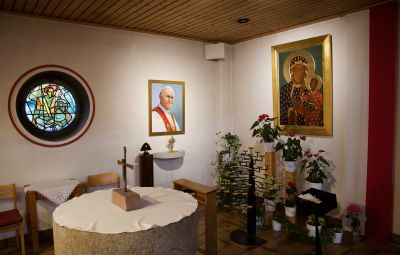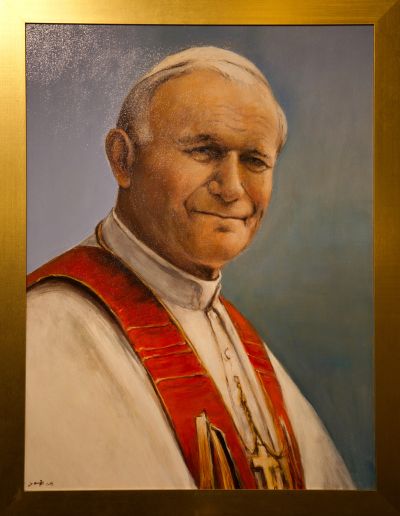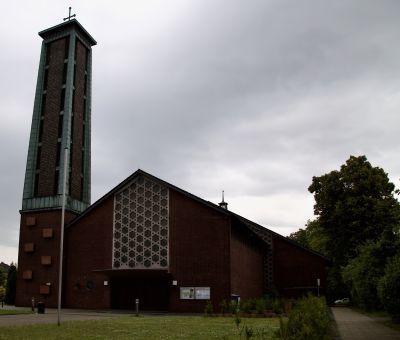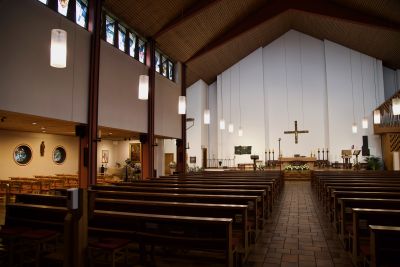The Black Madonna of Częstochowa in Essen-Altendorf

Today, the district of Altendorf in Essen does not really look like a Christian area, at least not at first sight. In fact, overall, if the press is to be believed, it has a reputation of being a problem area with high crime rates and much social conflict. It is therefore all the more surprising when you enter the St. Clemens Maria Hofbauer church (1751–1820; church built in 1957/58). The church served at least some of a Polish-speaking congregation in the diocese of Essen after 1985, and since 2006, it has been the centre of the entire Polish-speaking religious community there. On entering the church, named after a figurehead of the “Romantic” Catholic restoration during the 19th century, there is a sense of vibrant Catholicism everywhere. You immediately notice a full devotional ensemble consisting of the merciful Jesus, a blood relic of the Polish pope John Paul II (1978–2005) and, most importantly, the Black Madonna of Częstochowa. The image of Mary is even used as a cover photograph on the website for all the native speaker communities throughout the “Ruhr diocese”. The version on display in the church was created around 2008 and is now the ninth copy to be found in Essen-Altendorf. During the Corpus Christi processions in the community, her prominent position is assured.
A sacramental piety
All three of these objects testify to a vibrant Catholic faith with clearly identifiable Polish roots. The depiction of the merciful Jesus with the characteristic two rays of light emanating from his heart can be traced back to a vision of the Polish nun, Faustyna Kowalska (1905–1938), who has now been proclaimed a saint. John Paul II was the first Pole to become pope and his fight alongside Solidarność against the communist regime in his homeland has not been forgotten. Hardly anything more needs to be said in this respect. Ultimately, the copy of the Black Madonna, probably the most important object in this devotional triangle, reflects the national Catholicism of Poland, which continues to be of great importance. She is the focus of a large number of stories and legends, such as the miraculous defence of the Polish monastery in Częstochowa against Swedish soldiers in 1655 during the Second Northern War (1655–1660/61). The copy in Altendorf clearly shows the sword marks on Maria’s right cheek. These marks were inflicted on the original figure during an attack on the monastery in the 15th century, and were consciously left in place during the subsequent restoration work on the Black Madonna as a reminder of the events that occurred. The copy in Essen also includes these marks. The Black Madonna does in fact fit in well with the Ruhr region overall. After all, while the Golden Madonna may be regarded as the ‘queen’ of the diocese of Essen, the Black Madonna offers a kind of companion figure for Polish-speaking Catholics along the Ruhr; in Poland, the Black Madonna was proclaimed ‘queen’ of the nation in 1656. Anyone looking at the figure will quickly recognise that what may well be the most important relic for Polish Catholic pilgrims means more than just the veneration of Mary. The Madonna, with her black dress and golden lilies, which express her immaculateness, is holding the baby Jesus, clothed in red, in her hands, directing our gaze beyond herself to the son of God, who in turn holds the Holy Scripture in his left hand and blesses the viewer with his right. Here, she is presented in a similar way to the “Hodegetria” icon (Greek for “She Who Points the Way”).
Polish Catholicism, according to the Essen priest Jerzy Wieczorek SChr (Societas Christi pro Emigrantibus) is rooted above all in piety, which is kept alive by blessings of this kind, and by the sacraments. That’s probably the reason why during the pandemic, up to 4,000 viewers joined the congregation online for its Sunday services. In Germany and abroad, Catholics participated in the Eucharistic mass in Altendorf using the standard online streaming services. Father Wieczorek from the Christi society for the pastoral care of emigrants (Gesellschaft Christi für Emigrantenseelsorge) is responsible for the Polish community there, together with another priest and a nun. He points to another aspect of sacramental piety of this kind: the opportunity for daily confession, which is in great demand. It is not unusual for confessions to last between two and three hours. These forms of religious observance, as well as other activities such as a Sunday school for children, are reminiscent of aspects of Catholic life that were commonplace in the Ruhr region during the 19th and early 20th centuries: a close network of groups and associations which followed the liturgical rhythm of the festival calendar. While by the 1960s at the latest, the German-speaking Catholic community was in decline, in Essen-Altendorf in 2021, it still appears to be very active. However, in earlier times, there was no such thing as “one single” Catholic environment, any more than there is a single type of Polish Catholicism today. The Polish-speaking community, which also has branches in Mülheim and Lüdenscheid, includes members who speak different dialects and who follow different religious traditions from Poland.
The ‘black’ Ruhr region
The vibrancy of the Polish-speaking community today is in part due to the arrival of so many Polish Catholics to the booming industrial region around the Ruhr river at the end of the 19th and the beginning of the 20th century. After all, the history of Polish-language pastoral care along the Ruhr goes back beyond the creation of the diocese of Essen in 1958. During the 19th century, Poles were already arriving in the Ruhr region in large numbers, seeking work in the newly established industrial centre. In order to be able to continue their Catholic way of life far from their homeland, they founded a number of different groups and associations. For the city of Essen alone, there are records of 16 (!) organisations that were active before the Second World War. The Eucharist was celebrated in Polish in nine congregations in Essen right through to the early 1930s. The myth of the ‘red’ Ruhr region is therefore not entirely accurate – neither then, nor now. The Catholicism of the earliest Polish miners meant that for a long time, the population in the Ruhr region tended not to vote ‘red’, but rather ‘black’; in other words, they voted for the Catholic Centre Party.
Before and after 1945
The rise of National Socialism caused upheaval among the Polish Catholic community along the Ruhr. The cult of Germanness promoted by Hitler and his vassals brought about a temporary end to foreign-language masses and to Catholic life as a whole. The Polish Christi society for the pastoral care of emigrants mentioned earlier organised the re-establishment of the Catholic community after 1945. During the Second World War, the order had already smuggled four priests from Poland over the German border incognito to provide spiritual care for Polish forced labourers. In the post-war years, they continued to support the community in North Rhine-Westphalia, this time on an official basis. After the alleged “zero hour” in 1945, a great deal of hard work and commitment was invested in providing pastoral care for Polish emigrants, with a support organisation for men, a school and a centre offering charitable services. There was close cooperation between the Polish missionaries and Bishop Franz Hengsbach (1910–1991), who since his vicariate in Herne had been a particularly important figure in providing spiritual support for Polish Catholics, and who later played an important role in the process of reconciliation between the German and Polish episcopal conference. The Polish-speaking congregation also worked closely with ‘worldly’ Polish organisations in the region; here, groups that supported the government and those which were critical of it were unified by their Catholic faith.
The “Committee for the Defence of the Parish”
However, the history of the Polish-speaking Catholic community in Essen is not purely a success story. Since the 1980s, Polish organisations in Germany overall have faced the challenge of a dwindling membership. In 2005, in light of these declining numbers and the general restructuring of the diocese, the bishopric of Essen felt it necessary to axe the funds for one of the vicar posts, which led to a drastic response within the community. The removal of the vicar would have meant a reduction in the number of Polish services and other activities within the congregation. The decision was made to create a “Committee for the Defence of the Parish”. In the view of the committee members, the decision of the bishopric of Essen was unacceptable, since at the same time, John Paul II had declared 2005 the year of the Eucharist. Was it not a contradiction in terms, in the face of such an initiative, to do away with a priest’s post, and thus also the post of a celebrant? Not only that: the number of people attending mass had just begun to increase again. Many members of the community feared that losing a priest might lead to further measures, including even the abolition of the Polish mission. Finally, an agreement was reached that the vicar’s post would remain intact due to the high level of commitment among the congregation, which culminated in a signature campaign. Just a few weeks later, it was announced that the Polish Catholic mission would no longer be based in the St. Mary’s church in Essen-Steele. When Bishop Genn’s ideas for this restructuring process were first read out in a mass before the pulpit, some of the worshippers who were in attendance stayed on after mass had ended to pray for a fortuitous future for the mission – and knelt before the Madonna of Częstochowa. It would thus not be accurate to simply claim that Catholicism in the Ruhr region in the 21st century is in decline, as the example of the black ‘Maria’ in Altendorf shows.
Florian Bock, October 2021
Further reading:
Leonard Paszek (ed.): Dzieje polskojęzycznego duszpasterstwa w Essen. Geschichte der polnischsprachigen Seelsorge in Essen, Essen/Katowice 2007.
Borrowed with the kind permission of the Aschendorff Verlag publishing house
Original article:
Florian Bock: Das katholische Milieu lebt? Die Schwarze Madonna von Tschenstochau in Essen-Altendorf, in: Florian Bock, Sebastian Eck, Miriam Niekämper and Lea Torwesten (eds.): Geschichte(n) des Bistums Essen in 30 Objekten, Münster 2021, p. 138–143.








